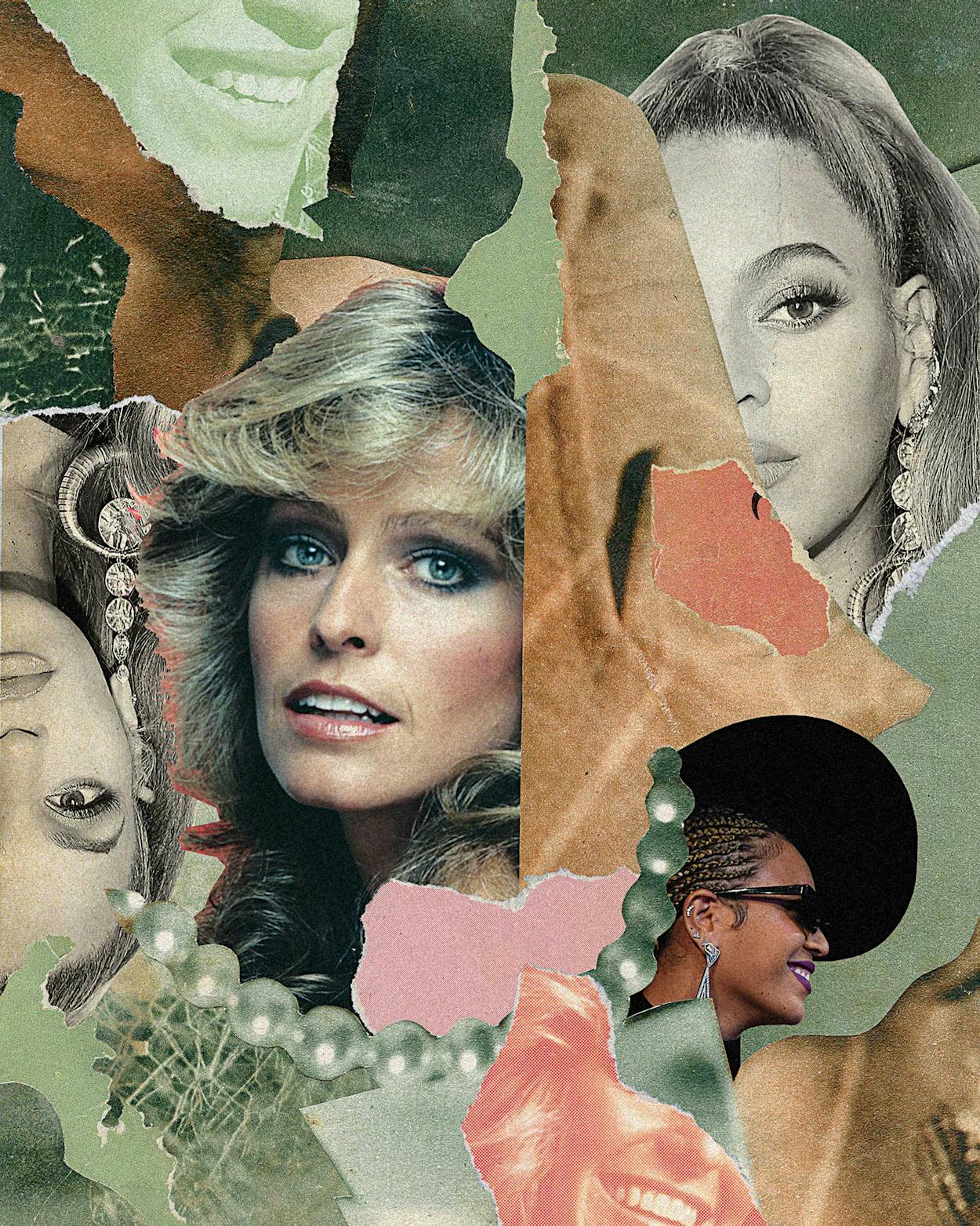It’s funny, but when I looked back recently at the famous Farrah Fawcett poster from 1976, I saw it in a completely different way. If you were, say, 12 or older back then, you know the shot I’m talking about: the one of the 29-year-old, breathtakingly stunning Texan who was fast becoming the star of the TV hit Charlie’s Angels and was destined for icon status. The Corpus Christi native was grinning in a scarlet one-piece bathing suit, her blond hair expertly tousled and her nipples prominent and perky against the fabric—a pretty racy display for the time. It’s a photo that launched the sexual fantasies of millions of boys and the nightmares of probably an equal number of girls who knew they could never measure up to that standard of beauty, no matter how hard they tried.
You could claim that the photo captured a new kind of woman—Fawcett looked so fresh-faced and natural and free compared with our trussed and helmet-haired moms—but I wonder now if that poster doesn’t represent the end of something more than the beginning. What strikes me most when I gaze at the photo today is how forced Fawcett’s smile looks, too wide, too toothy, and, yes, too eager to please. It was work: Texas beauty was an export, like oil or cattle. That we produced an abundance of gorgeous women was another reason we were unique and important, another point of pride.
Fawcett didn’t invent that iconic style so much as she embodied it. The look—which was more Texan than it was all-American—was casual, outdoorsy, dreamy, and, most important, sexy. Everything about her spoke of South Texas ranches and the University of Texas at Austin, which Fawcett attended in the sixties, sometimes barefoot. She wasn’t the virginal, freckle-faced Midwestern girl next door, nor was she the intellectual, worldly, and sophisticated—threatening—New Yorker. And, of course, Fawcett was blond and turquoise-eyed, almost handsome with her long nose and elegant jawline; she was a classic beauty, which meant classically white. (Though she would claim to be part Choctaw.) There were lots of Latinas and Black women and women of other ethnicities and races in Texas whose beauty might have been equal to Fawcett’s. But they went unnoticed or, at the very least, were undervalued by the white (mostly male) majority who decided such things.
Fawcett did control her image more than many women of her time—she had the right to pick the photo that became the poster—but her options and her imagination were limited by the society around her, as evidenced by her failure to be taken seriously as an actress, despite excellent performances in meaty roles, and by the tabloids’ cruelty toward her as she aged. (I profiled her in the early 2000s, a little less than a decade before her death from cancer. She was tiny and frail, had had too much work done, and didn’t seem to be having a very good time at all, in general a prisoner of her doomed-from-the-start failure to sustain the image she had created.)
So, for a lot of reasons, it’s comforting to see that over the past fifty years the ideals of Texas beauty have grown as diverse as our population, our restaurant scene, our local politicians, and our local news anchors. (Not to mention that a Fawcett-style pinup in any office these days would be a recipe for a harassment suit.) We’ve witnessed the various catastrophes of Anna Nicole Smith, but we’ve also celebrated the triumphs of Eva Longoria; Lizzo and Megan Thee Stallion have pushed the boundaries of conventional beauty with an infectious joie de vivre.
You probably know where I’m going here: there is one Texas woman whose looks embody our time as much as Fawcett’s did half a century ago, and her name is Beyoncé. It should surprise no one that our reigning beauty queen is not white, since Texas is now a vastly diverse, majority-minority state. And it makes sense that there’s not one iconic Beyoncé image but many. Women today fill myriad roles—sometimes more than any human being should be asked to bear—and the Houston icon leads the pack, working as a singer, dancer, songwriter, fashion mogul, video auteur, arts patron, civil rights activist, and feminist provocateur.
And thanks to the kind of masterful media control that Fawcett would have envied, Beyoncé-as-beauty-queen is almost impossible to pigeonhole. Heavily made-up and regally styled, she can look like the lead in a yet-to-be-announced Game of Thrones sequel. At other times she looks like the 41-year-old mother of three she is, albeit one whose skin, hair, body, and psyche have been as well tended as humanly possible. Even then, though, Beyoncé’s got it going on—in an otherwise benign family photo, she’s the one wearing dark, cat’s-eye sunglasses. She looks like a woman firmly in control of her life and career, unlikely to ever experience the sort of public decline Fawcett endured.
There’s your fifty-year span writ large: In Fawcett’s time, the come-hither smile that sold a zillion posters contrasts starkly with virtually any photo of her successor. Beyoncé’s visage and her often boldly displayed body telegraph ferocity, strength, and independence, freedom from male domination, from the worst ravages of racism, from any limits on her ambitions or desires. Maybe that image is as manufactured as Fawcett’s seventies smile, but it’s the one Texas women—and women around the world—crave now.
This article originally appeared in the February 2023 issue of Texas Monthly with the headline “Tex Appeal.” Subscribe today.
Image credits: Farrah Fawcett: TV Guide/Courtesy of Everett Collection; Beyoncé portrait: Kevin Mazur/TIDAL via Getty; Beyoncé profile: Kevin Mazur/NARAS via Getty
- More About:
- Music
- Film & TV
- Farrah Fawcett
- Beyoncé









